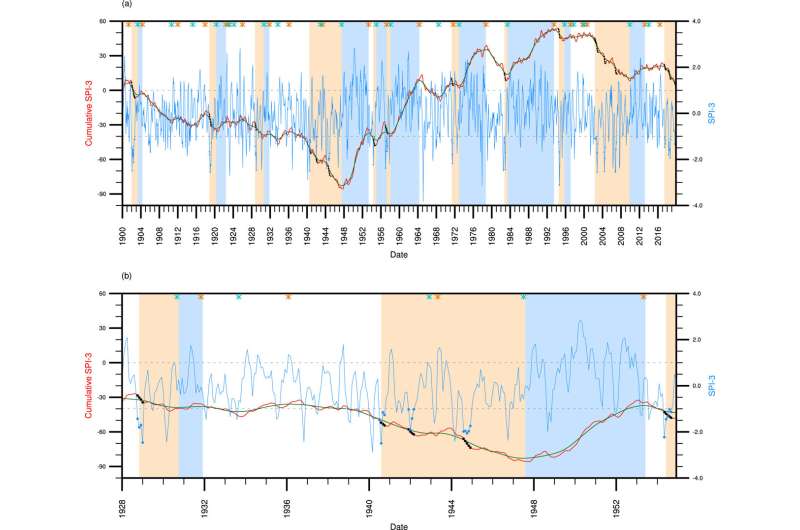Study links heavy rainfall decline to drought

A new study has linked subtle changes in the wettest weather to the occurrence of drought across Australia.
The study, led by Dr. Tess Parker from the Australian Research Council Centre of Excellence for Climate Extremes at Monash University, shows that a few days less of heavy rainfall annually contributed to severe drought.
The study comes as the State of the Climate report, released today, signals southern Australia's long-term rainfall decline.
The authors used 120 years of Australian rainfall data to show that the absence of just 3-5 heavy rainfall days was typically responsible for well over half of the rainfall decline during past droughts.
"The majority of rainfall comes from these heavy rainfall days (above 20 mm/day), which is typically only 1-2 weeks' worth of annual rainfall, sometimes less," Dr. Parker said.
"But it's the slight reduction of this heavy rain, equivalent to around five or fewer days per year on average, that is responsible for most of the rainfall decline during past drought, right across Australia."
The study also shows that when droughts break, it's because these days of heavy rain return. However, they often lead to wetter than normal conditions.
"Droughts typically break in spectacular fashion because those heavy rain days return to excess, rather than just returning to normal. This shows that drought-breaking rains can also be down to relatively few, but heavy, rainfall events," Dr. Parker said.
"In wetter climates, like on the east coast, it's days with rainfall above 50 mm that make the biggest difference."
Dr. Parker described the significance of the result lies in the links that can be made to rain-bearing weather systems that cause the heavy rainfall that make and break droughts.
"Our study has isolated the importance of days of heavy rainfall for drought development and recovery. Now this is known, we can begin to investigate the types of weather systems related to these heavy rainfall days, which will reveal a lot about important meteorological processes that send us into and out of drought," Dr. Parker said.
According to the BOM, of all the climate challenges to afflict Australia, drought is one of the most feared, and costly. Much of southern Australia experienced a prolonged Millennium drought 1997–2010. Apart from crop failure and stock loss, droughts set the scene for bushfires, dust storms, and land degradation.
"Effective monitoring and prediction is required to manage and mitigate the socioeconomic effects of drought. This requires knowledge of how droughts begin, develop and recover, and the underlying processes related to these stages of drought," Dr. Parker said.
The study was published in the journal Weather and Climate Extremes.
More information: Tess Parker et al, The role of heavy rainfall in drought in Australia, Weather and Climate Extremes (2022). DOI: 10.1016/j.wace.2022.100528
Provided by Monash University





















